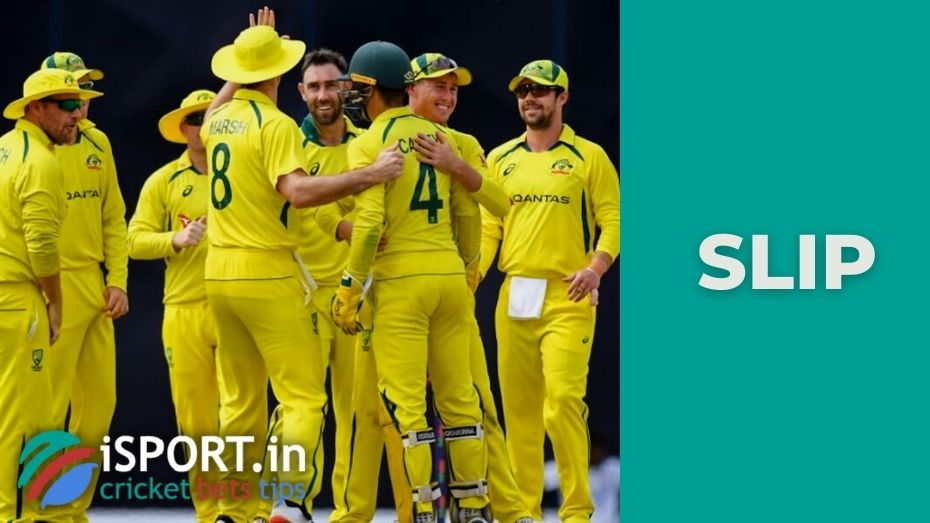Slip

Slip is a fielder who is positioned behind the batsman next to the wicket-keeper on the Off side. Accordingly, the positions of these fielders are often called “In the slips/at first slip”. As a rule, captains put two or more slips on the attacking side and no more than one on the opposite side, although the rules do not contain strict restrictions on this issue. So, for example, in the first test match against the West Indies in 2004, the British fielded seven slips. However, the truly record number of slips was the episode of the ODI competition, in which the national teams of Australia and Zimbabwe took part: the first fielded nine slips (thus, the only players who were not included in this list were the bowler and the wicket-keeper).
The main goal of a slip fielder is to catch a ball that is directed at an angle that is inconvenient for the wicket-keeper or has fallen into a zone that is out of his reach. Interestingly, John Nyren, who wrote a book about cricket in 1833, mentioned the initial connection between the Slip and Long Stop positions: in the second case, the player was located directly behind the wicket-keeper and had to intercept as many unsuccessfully taken or missed balls that went to the Leg side and Off side. Long stop can still be found at provincial competitions, but it was decided to abandon it in professional cricket.
Depending on how many slips are on the field, commentators can label them as “first slip”, “second slip”, “third slip”, and so on. It is noteworthy that the so-called Floating slip may also appear in this list. This player is more often involved in competitions that take place in the format of limited overs; his task is to cover the entire slip zone, actually replacing several fielders at once.
It is worth noting that the distance from the slip to the batsman may vary. The key factor here is the bowler’s feed rate: the higher it is, the further the slip will go. In addition, captains, as a rule, prefer to put fewer slips against spin bowlers than against fast attacking players.
The slip position can be claimed primarily by those players who have good reflexes and have enough experience not to miss the ball in a difficult episode. It is not surprising that the best batsmen of the team get this opportunity more often than others, but even they achieve optimal results only if they interact well with the attacking players. So, in particular, in order to give the slip the opportunity to intercept the ball, the attacking player must have a wide range of deceptive strikes in his toolkit with a bias to the Off side.
Also, the term slip can be used to denote the area of the playing field that a particular fielder occupies or to clarify his position (for example, “the ball passed through the second slip” if the fielder failed to catch a projectile).
The best slip fielders in the history of cricket are considered to be:
- Rahul Dravid (India);
- Mark Waugh (Australia);
- Brian Lara (West Indies);
- Sunil Gavaskar (India);
- Shane Warne (Australia);
- Michael Clarke (Australia);
- Garfield Sobers (West Indies);
- Bobby Simpson (Australia);
- Ian Chappell (Australia);
- Jacques Kallis (South Africa);
- Brian McMillan (South Africa);
- Mark Taylor (Australia);
- Ricky Ponting (Australia);
- Vangipurapu Venkata Sai Laxman (India);
- Mahela Jayawardene (Sri Lanka);
- Stephen Fleming (New Zealand) and some others.
Another position that is indirectly related to slip is gully, invented in the last third of the century before last by Arthur Jones, who later became captain of the England national team. His idea quickly gained popularity and became widespread since the very location of the gully is potentially inconvenient for a player with a bat (on an imaginary line from the On side corner of the popping crease to the Middle stump in the direction of the Slip sector).
And finally, it is impossible not to mention one more position that is related to slip – namely, Leg slip. It is located on the opposite side from the usual slips in relation to the wicket-keeper, and, as a rule, the captains either do not cover it at all or cover it at a minimum. The fact is that Law 41, paragraph 5 explicitly prohibits placing more than two players on the segment between Square leg and Long stop, so in most cases, the Leg slip place remains vacant.
This is interesting: a player who constantly performs in a slip position is often referred to as a slipper.
You can bet on your favorite team with Bet365 promo code.
